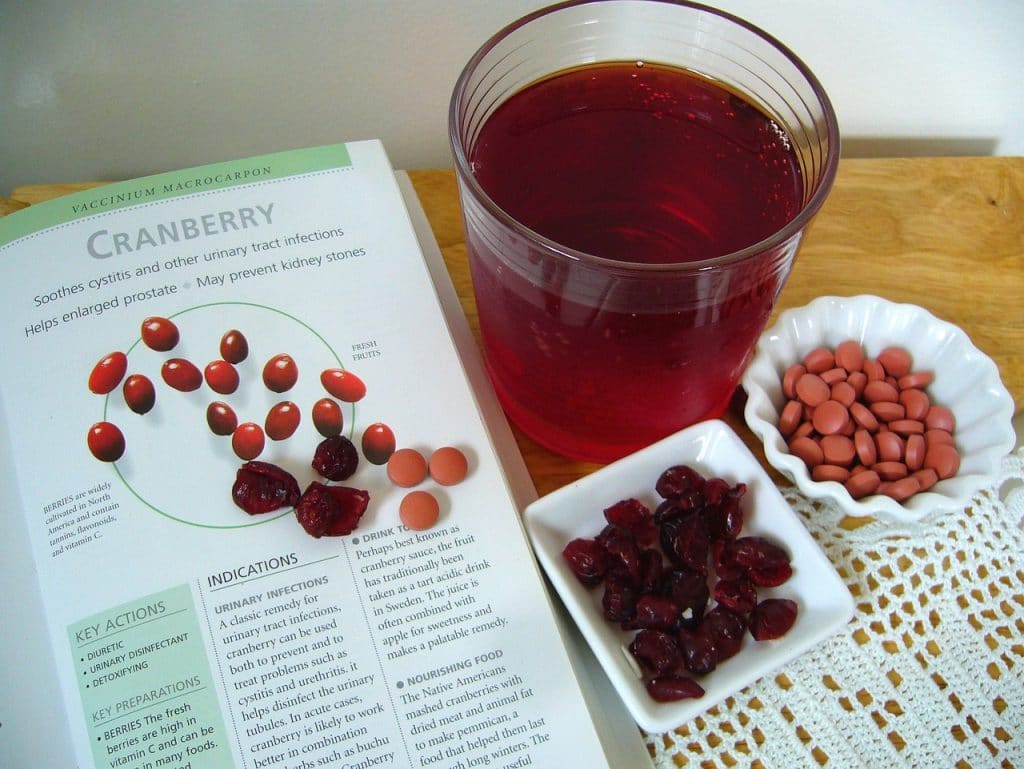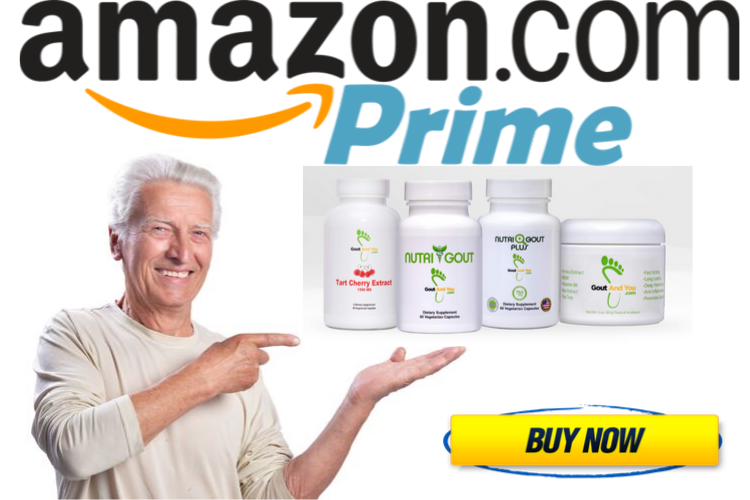
Here you’ll discover why cranberries are considered a superfood, what they can do for your general health, and how they may impact your gout condition.
Cranberries and Gout
Cranberries are small, round/egg-shaped, red berries — related to blueberries, bilberries, and huckleberries — that grow on low trailing vines, rather like strawberry plants.
The United States is, by some margin, the biggest producer of cranberries in the world, followed by Canada and then Chile. These three countries together accounted for some 98% of the world’s cranberry production in 2017.
Around 400 million pounds of cranberries are consumed by Americans each year. It’s estimated that 95% are processed into juice, sweetened dried cranberries, jams, jellies, and sauces. Only 5% are sold fresh: cranberries in their raw state being so very tart and bitter.
Health Benefits of Cranberries
Cranberries have been used for centuries as a natural medicine for things like scurvy (vitamin C deficiency), wound healing (poultices), gastric problems, urinary conditions, and more.
What we know today is that cranberries are rich in antioxidants which help to neutralize free radicals in the body that are linked to chronic health conditions such as heart disease, atherosclerosis (hardening of the arteries), diabetes, Parkinson’s, Alzheimer’s, chronic inflammation, and cancer.
According to WebMD:
One cup of whole cranberries has 8,983 total antioxidant capacity. Only blueberries can top that: Wild varieties have 13,427; cultivated blueberries have 9,019.
And we also know that fresh cranberries are rich in dietary fiber, vitamins A, B5, B6, C, E, and K, manganese, magnesium, potassium, iron and copper.
Because of their rich antioxidant and nutrient content, cranberries have been labeled a “superfood” that may help to:
- maintain a healthy nervous system
- improve gut health
- boost the immune system
- enhance oral health
- lower blood pressure
- lower the risk of type-2 diabetes
- aid cardiovascular health
- reduce the risk of urinary tract infections (although study findings are mixed)
But, notwithstanding their superfood status, should you be consuming cranberries and cranberry products if you have gout?
Gout and Diet
Gout is a form of inflammatory arthritis characterized by the sudden onset of extreme pain and swelling around the joints and connective tissue (known as a gout attack or gout flare), most often in the joint at the base of the big toe, although any joint can be affected.
The root cause of gout is the presence of unusually high levels of uric acid in the blood, a condition called “hyperuricemia”, out of which microscopic crystals of monosodium urate are precipitated in the joints and surrounding tissue. A gout flare is actually caused by your body’s natural inflammatory response to these crystals.
Uric acid itself is a byproduct of the natural breakdown of chemical compounds called “purines” in your body’s cells and the cell’s of the food you eat. It’s estimated that consumed food accounts for some 30% of the total uric acid produced in the body.
But purine levels range from relatively low to relatively high across different food types, which is why gout patients are generally advised to change to a low-purine diet, which means avoiding or limiting high-purine foods such as organ meat, game, red meat, poultry, and seafood.
So the purine content of any food item needs to be carefully considered before adding it into your diet.
Another key consideration is sugar: studies have also associated sugar (especially fructose) with increased uric acid and a heightened risk of gout.
And yet another consideration is whether a food is acid-forming or alkaline-forming when digested. In terms of gout management, alkaline-forming foods are good whilst acid-forming foods aren’t quite so good, as you’ll discover shortly.
So let’s take a look at the purine and sugar content and the acidity/alkalinity of cranberries…
Purines in Cranberries
Cranberries are considered to be low in purines, i.e., producing less than 100 mg uric acid per 3.5 oz (100 g) serving.
So, in terms of their purine content alone, cranberries would be safe in a gout diet.
Sugar in Cranberries
Fresh Cranberries
Fresh cranberries are relatively low in sugar: around 4 grams of natural sugars per 100 grams (1 cup) of berries.
Raw cranberries are safe to eat in a gout diet as far as their sugar content goes.
Cranberry Products
A 1/4 cup of dried cranberries contains about 22 grams because drying concentrates the natural sugars. And some brands add even more sugar to offset cranberry’s natural tartness.
It’s a similar story with cranberry juice: even unsweetened juice contains around 30 grams of natural sugar per cup. Sweetened juice has even more added sugar.
Cranberry sauces, jams and jellies are loaded with similar amounts of sugar too, sometimes a lot more.
So cranberry products would not be a safe addition to your gout diet.
Cranberry — Acidic or Alkaline?
The level of your body’s acidity or alkalinity is measured using the pH (potential of hydrogen) scale which ranges from 0.0 (most acidic) to 14.0 (most alkaline), 7.0 being neutral.
pH values below 7.0 are acidic, with acidity increasing towards 0.0. pH values above 7.0 are alkaline, with alkalinity increasing towards 14.0.
A 2012 study by Kanbara and colleagues concluded that diet-induced alkaline urine excretes more uric acid than acidic urine, with a corresponding reduction in serum (blood) uric acid.
It’s thought this happens because less uric acid is reabsorbed back into the bloodstream with alkaline urine than with acidic urine.
In other words, acidic urine promotes uric acid reabsorption which then raises uric acid levels in the blood. Not only that, an acidic urine environment encourages the formation of uric acid kidney stones.
So someone with gout needs to maintain their urine slightly alkaline to reduce the risk of gout flares and urate kidney stones.
But cranberries have a pH value around the 2.4 mark, making them a very acidic food. This promotes the development of a more acidic urine environment that, according to Kanbara, increases blood uric acid which, of course, raises the risk of gout flares and urate kidney stones.
However, acidity in and of itself isn’t a reason to discount a food out of hand, since some acidic foods, such as cranberries, are highly nutritious. And the pH value of your urine is determined by the totality of your diet, not by any one food, unless that food is taken to the extreme.
A slightly more alkaline urine environment — which is what we gout sufferers desire — can be achieved through a balanced diet of 70% alkaline-forming foods and 30% (healthy) acid-forming foods.
Most vegetables and fruits are alkaline but some acidic fruits, such as citrus, are actually alkaline-forming when ingested as they stimulate the production of alkaline compounds in the body. So it isn’t difficult to get that 70/30 balance.
So are cranberries safe to eat with gout?
Processed Cranberries
Because of their high sugar content cranberry juice, dried cranberries and cranberry sauces, jams and jellies would not be considered safe for gout so would need to be avoided or, at the very least, consumed very sparingly.
Fresh Cranberries
On the other hand, fresh cranberries would be considered safe. However, tart fresh cranberries aren’t to everyone’s taste, even when chopping them up and adding into things like breakfast yogurt, cereals, salads, and the like.
So one way to get the health benefits of cranberries without the tartness and without added sugar could be through supplementation.
Cranberry Supplements
The manufacturing process removes all or virtually all of the sugar content. Unfortunately, it also removes some nutrients, although antioxidants, vitamin C and minerals like manganese and calcium are largely retained.
In other words, a good deal of the benefits found in fresh berries should still be available in high quality supplements.
So cranberry supplements in the form of tablets or capsules may be a simple way for people with gout to enjoy the overall health benefits of cranberry without the unpleasant tartness and without the sugars.
But choose long-established, trusted brands with bona fide seals of approval, and carefully read the labeling to check if you’re allergic to any of the ingredients and for side effects.
Note: You should talk to your your doctor or healthcare professional before taking ANY cranberry product (supplement, fresh, juice, dried, jelly, sauce) if you:
- Take warfarin. The vitamin K in cranberries can impede the blood-thinning action of warfarin.
- Have a history of kidney stones. Cranberries contain oxalate a natural compound that combines with calcium to form calcium-oxalate kidney stones.
- Are allergic to aspirin. Cranberries contain salicylic acid, a derivative of aspirin.
- Are pregnant or breastfeeding. There’s probably not enough reliable data about the safety of taking cranberry when pregnant or breast feeding.
- Take other regular medication. Apart from warfarin, cranberry may interact with other prescribed and over-the-counter drugs too.
But there’s really no need for cranberry supplements if you…
Choose other fresh berries instead.
Cranberry supplements need to be of the very highest quality to be effective and, therefore, can be quite expensive.
But there’s really no need for these expensive, manufactured supplements.
There are other highly nutritious berries out there that are also oxidant and nutrient-rich, but without the tartness and the need for added sugar. For example, blueberries, bilberries, cherries, and strawberries.
And, as you saw earlier, blueberries have even more antioxidant capacity than cranberries!
So fresh, ripe berries such as these will be a very nutritious, safe addition to your gout diet, without the need for expensive supplementation or added sugars.



